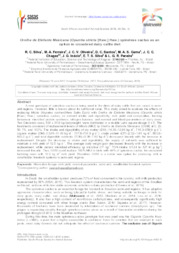Orelha de Elefante Mexicans (Opuntia stricta [Haw.] Haw.) spineless cactus as an option in crossbred dairy cattle diet.
Orelha de Elefante Mexicans (Opuntia stricta [Haw.] Haw.) spineless cactus as an option in crossbred dairy cattle diet.
Author(s): R. C. SILVA; M. A. FERREIRA; J. C. V. OLIVEIRA; D. C. SANTOS; GAMA, M. A. S. da; J. C. C. CHAGAS; J. G. INÁCIO; E. T. S. SILVA; PEREIRA, L. G. R.
Summary: Abstract A new genotype of spineless cactus is being used in the diets of dairy cattle that are raised in semiarid regions. However, little is known about its nutritional value. This study aimed to evaluate the effects of replacing Miúda (Nopalea cochenillifera Salm Dyck) with Orelha de Elefante Mexicana (Opuntia stricta [Haw.] Haw.) spineless cactus, on nutrient intake and digestibility, milk yield and composition, feeding behaviour, microbial protein synthesis, nitrogen balance, and ruminal and blood parameters of dairy cows. Ten Girolando cows, 500 ± 51.6 kg bodyweight, were distributed in a double Latin square design 5 x 5. The treatments consisted of replacement levels of Miúda (MIU) by Orelha de Elefante Mexicana (OEM) at 0, 25, 50, 75, and 100%. The intake and digestibility of dry matter (DM) (14.38?12.95 kg d-1, 716.3?658.9 g d-1), organic matter (OM) (13.01?11.43 kg d-1, 747.8?704.8 g d-1), crude protein (CP) (2.02?1.61 kg d-1, 863.8?845.2 g d-1) and total digestible nutrients (TDN) (9.38?7.92 kg d-1) decreased linearly with the increase in replacement. Despite the decrease in intake and digestibility, the supply of nutrients was sufficient to maintain a milk yield of 12.5 kg d-1. The average daily weight gain decreased linearly with the increase in replacement, while protein microbial efficiency (g microbial CP kg-1 TDN intake; 91.24 to 127.44 g kg-1) increased linearly. Thus, OEM could replace 100% MIU in diets with 48% of spineless cactus, for crossbred lactating cows with 12.5 kg d-1 milk yield. Therefore, OEM is a viable new option for producing milk in smallholder livestock systems in semi-arid regions.
Publication year: 2018
Types of publication: Journal article
Unit: Embrapa Dairy Cattle
Observation
Some of Embrapa's publications are published as ePub files. To read them, use or download one of the following free software options to your computer or mobile device. Android: Google Play Books; IOS: iBooks; Windows and Linux: Calibre.
Access other publications
Access the Agricultural Research Database (BDPA) to consult Embrapa's full library collection and records.
Visit Embrapa Bookstore to purchase books and other publications sold by Embrapa.

